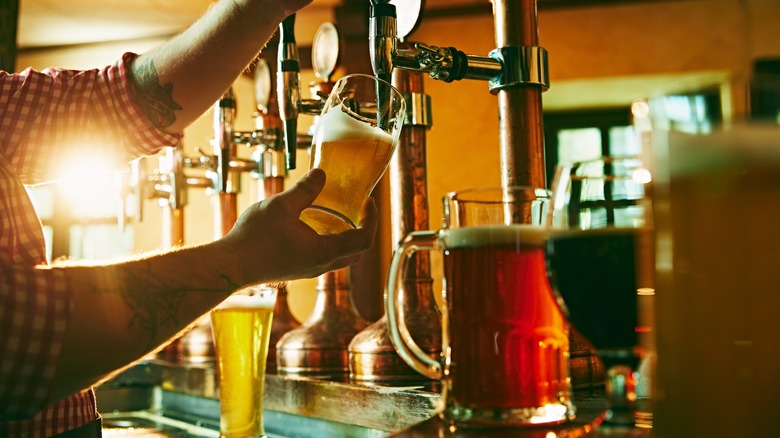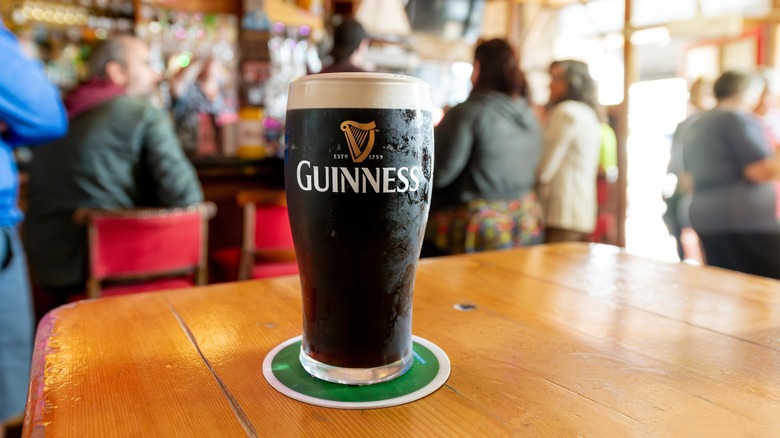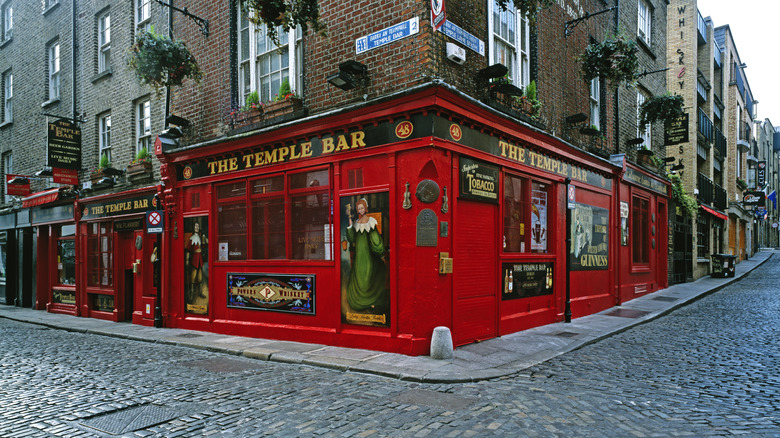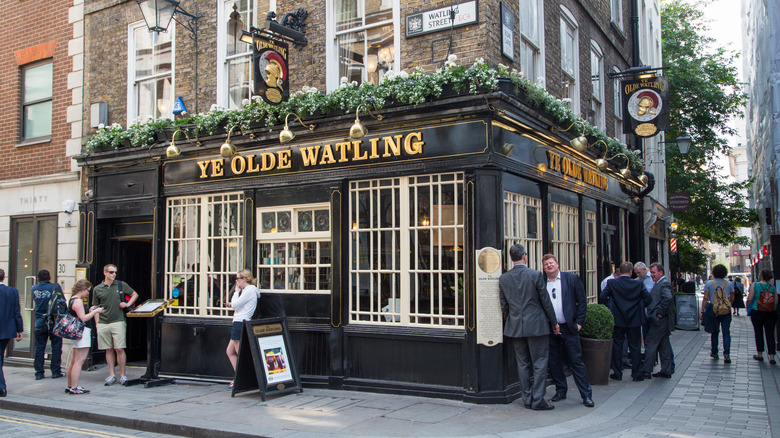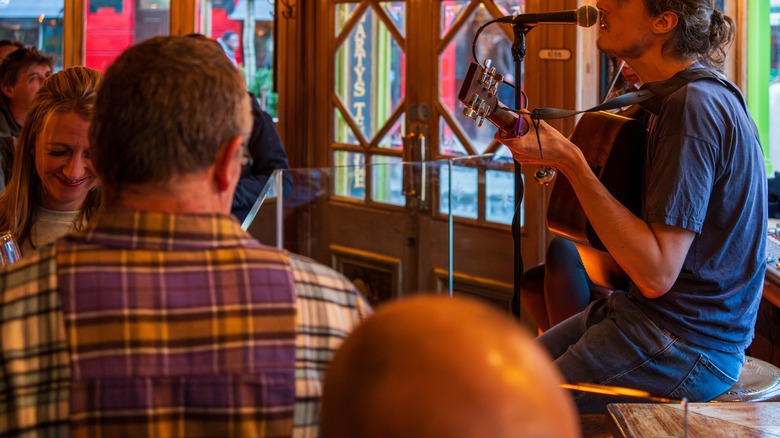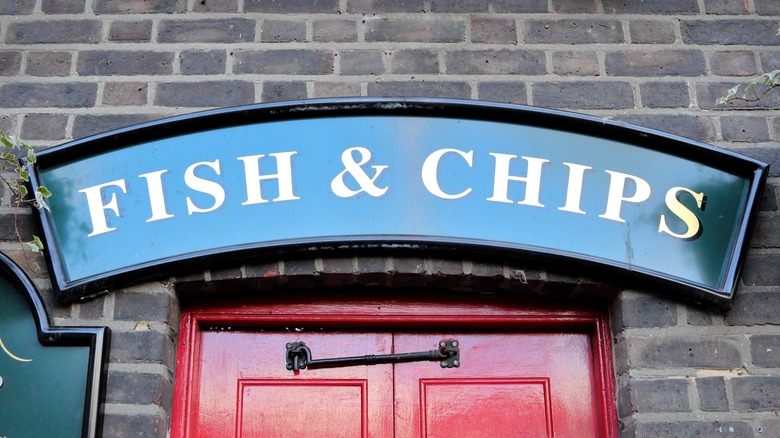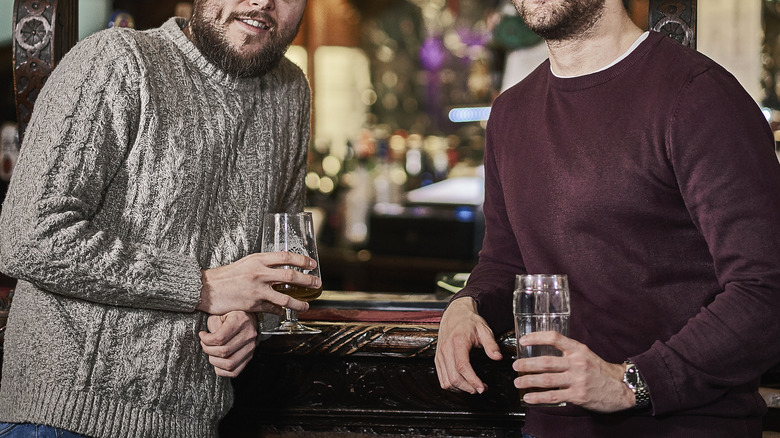Irish Vs English Pubs: Is There A Difference?
Just as we explored why the dive bar is so difficult to define, trying to capture what makes a pub is no small feat. The matter is even more complicated when peering through the microscope of cultural idiosyncrasies — step into either or both, and barflies will recognize immediately that Irish and English pubs are not at all the same thing. So what exactly makes them unique and different? (This writer is a career pub-goer, first-time pub-definer!)
Pubs are all about a low-key atmosphere of warmth and welcome. These are the places where dark, cozy, polished wood interiors house a sub-current of local flair and hometown pride. Unlike "cool" dives, "warm" pubs are friendly enough for well-known barflies and total newcomers alike to grab a stool and strike up a cheerful conversation. The typically informal relationships between bar owners and regular patrons adds a level of camaraderie and intimacy, strengthening community culture overall beyond the walls of the pub. Inside, the menu centers around affordable draft lagers served in mass quantities (don't order a cocktail). So what exactly is the difference between these establishments with their nuanced cultural influences?
In general, Irish pubs feature a wide array of Irish stouts, lagers, and whiskeys, are more family-oriented as an accessible community gathering place, serve limited food menus, and commonly house live music performances. Comparatively, English pubs tend to serve wider food menus, a global array of beers, and place a heavier emphasis on sports.
What is an Irish pub?
Irish pubs are all about community gatherings and good times, within the Emerald Isle and beyond. The walls are often adorned with vintage Irish stout signs and flags of Ireland. Framed newspaper clippings of Gaelic football victories might also be spotted. The pub is a community hub, bringing together casual weeknight sippers and traditional Irish music played by live bands, full of character, friendliness, and unpretentious local pride. Word to the wise: In Ireland, "the toilet" is "the jacks." In an Irish pub in America, you can just call it the restroom.
In Ireland, major milestones are celebrated at the pub, from birthdays to christenings, weddings, births, and deaths, so don't be surprised to see kiddos running around. Patrons under 18 are usually allowed in pubs but have to leave after 9 p.m. (or 10 p.m. between May and September). While Irish pubs in the U.S. are 21+, this welcoming community atmosphere reflects the Irish cultural emphasis on keeping it local, pleasure, camaraderie, and overall good times with good company — and it translates to the warmth of Irish pubs in America. The pub is a laid-back place to unwind with friends and ask, "What's the craic?," not a place to get rowdy or create a scene (the pub is not the club). Come on down to the pub and ask your man behind the bar for a pour of Guinness or Murphy's; it'll be grand.
What is an English pub?
Vibe-wise, English pubs can range from sticky, lower-priced, dive-like establishments to posh gastropubs serving full food menus of traditional British comfort fare. Wherever on the spectrum they fall, British pubs are a center of local culture and social life at large, but to a lesser degree on the family level than in Ireland. In the U.K. as well as the States, English pubs are where colleagues, friends, and college students often meet. Expect to see more dark wood panelling and at least one Union Jack flag.
English pubs are commonly sports-centric and divided based on which team they support. If The Red Lion is a Manchester United bar but The Green Dragon is a Liverpool bar, football fans in the U.S. and U.K. alike will want to know which one they're patronizing when they sit down to screen a derby match. After the game, patrons might step out to the pub garden to chuff a Benson & Hedges bine or a Silk Cut ciggie. When rare sunny weather strikes in the U.K., pub gardens fill.
Pubs are famously great places to strike up conversations. But unlike Irish pubs, a neutral opener like dry small talk about the weather, the song that's playing, or the football score is likely going to land better in an English pub than some good-natured Irish ribbing. Don't take it personally if no one feels like chatting either; it isn't considered out of place to patronize an English pub for quiet solo time.
Irish pub culture is steeped in working class history
Irish pub culture is steeped in a long working class history. Before the advent of the bar scene, folks flocked to public houses (colloquially shortened to "pubs") to drink without having to pay the door fees required at private, members-only drinking establishments. This intrinsic atmosphere of blue-collar sensibilities, meaningful social gathering, and avoiding an overpriced entrance fee has colored Irish pub culture from its conception.
Today, Irish pubs follow a casual dress code, and conversation often centers around banter and good-natured ribbing (aka "slagging"). In an Irish pub, joking around is a surefire way to make new friends; everyone drops their guards and no one takes themselves too seriously. Good humor is an especially great conversation starter with a stranger or newcomer in an Irish pub.
In a similarly intimate way, Irish pubs commonly rely on a small team of staff, just a handful of bartenders with familiar faces. The pub owner themself can commonly be spotted working shifts behind the bar. In Ireland, Irish pubs are commonly named after the street on which they're located or the name of the bar owner, keeping it simple and personal. Sean's Bar in Athlone, County Westmeath claims to be the oldest operating pub in the Emerald Isle (and maybe one of the oldest pubs in the entire world) — a community watering hole has been held at this address since it was an inn back in 900 C.E.
English pubs have been around since the crusades
The English pub was birthed from the Roman development of roadway systems. Around 43 C.E., folks began constructing retail units and wine bars called "tabernae" at the fronts of their houses to cater to passing road travelers. By the 400s C.E., this idea was translated from wine shops to taverns and alehouses, which appear in Geoffrey Chaucer's "The Canterbury Tales" and eventually evolved into pubs.
Today, England alone is home to nearly 50,000 pubs. Considering England spans 51,330 square miles, that shakes out to roughly one pub per every square mile (thirsty folks never have too far to go). Today, Nottingham's Ye Olde Trip to Jerusalem is considered the oldest still-operational pub in the country, dating back to the Crusades of the Middle Ages.
One of the most iconic signatures of English pubs is their signage. In 1393, King Richard II decreed that pubs must place some sort of sign in front of their premise to indicate that alcohol was being served there. Without a sign, the ale inspectors (a real job) could accidentally pass by these unmarked businesses during their rounds. Unlike the family and street names that inspire Irish pubs, English pubs typically take their names from local historical symbols, like the Crown, Mayflower, Bell, Lamb, or Flag. The most popular bar name in England today is The Red Lion. Signs at establishments with animal names (like Swan, Sheep, Elephant, etc.) often have no words at all, depicting only an illustration of the animal.
Irish pubs serve mainly Irish spirits by the pint and bottle, with limited food menus
It's no secret that Ireland has originated many of the most popular spirits enjoyed worldwide, and what better place to enjoy them than the pub? Step into an Irish pub and Guinness (aka "a pint of Gat") and bottles of Bulmers dominate the bartop. Expect to see a solid selection of Irish stouts like Murphy's, craft beers like Mescan, O'Hara's, and Smithwicks Kilkenny red ale, hard cider, and Irish whiskeys like Jameson or creamy Bailey's.
On the food side, Irish pubs tend to keep it fairly minimal, with common pub snacks including bacon fries, dry roasted peanuts, and potato chips, but not much else. Heartier fare like beef stew or warm buttered Irish soda bread scones can be found but aren't considered standard or expected. Here at Tasting Table, we recommend steering clear of any American-based Irish cocktails or anything dyed green for St. Patrick's Day. Although, patrons will hardly miss having something to munch on against the lively background of live whistle and fiddle music. In Ireland, trad session musicians hold a high social ranking in pub culture — be sure not to talk over the music, and never sit down in a musician's seat during a break.
English pubs serve global spirits and wider, legendary food menus
Comparitively, English pubs serve a more globally-focused selection of beers. Popular classic English beers include Abbot Ale, London Pride, Old Speckled Hen, Breakspeare, and Greene King IPA, but Italian Peroni, Dutch Heineken and Amstel, Spanish San Miguel, and Mexican Corona are also commonly served. Patrons can anticipate a selection of lagers, stouts, and pale ales, served by the pint or half pint.
Where English pubs rule the bar scene is their traditional British pub food: savory steak and ale pie, fish and chips, sausage and chips, a Ploughman's board with raw onions and spicy mustard, fish pie, Sunday roast, shepherd's pie, bangers and mash (which is named after a strange phenomenon), and full English breakfast served all day. Although, even with such a sprawling food menu, keep in mind that pubs are nearly always order-at-the-bar; if you're waiting for table service, you'll be waiting all night. Perhaps most importantly of all, the defining difference is that, in an English pub, you say "cheers" when clinking glasses, while in an Irish pub you say "Slaínte!"
The rounds system -- a crucial etiquette tip for both English and (especially) Irish pubs
Whether local or traveling from out of town, no barfly should step foot in an Irish or English pub without understanding the "rounds" system. In these European pubs, proper etiquette requires that patrons order a round for each member in their party, not just for themselves — one person goes to the bar for everyone. So if you've arrived at the pub with four friends, you would ask for five pints (and buckle in to drink four more pints before the end of the night).
If your group is on the larger side, parties might split into two distinct groups to facilitate the round-buying. If you don't want to toss back five beers, then make it clear at the beginning of the night that you will not be joining the round and are buying only for yourself. Although, keep in mind that the round system is expected even if you're drinking with just one other person.
Don't expect to be reminded when your turn is either. The rounds system operates on the unspoken trust that the favor will be returned, and "I forgot" isn't a super forgivable reason to miss getting your round in before the first person in your round goes up to buy again. The round-buying system is alive and well in English pubs but carries less social import and isn't always universally expected as the default the way that it is in Irish pubs.
